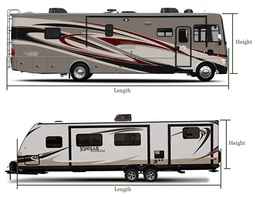When embarking on the journey of RV ownership, one of the most pressing questions that arise is: “How wide is a camper, or motorhome?” Understanding RV dimensions, particularly width, is crucial not just for practical considerations but also for the deeper fascination with the RV lifestyle. The allure of nomadic living, the ability to traverse diverse landscapes, and to create lasting memories with family and friends draws countless enthusiasts to the open road. Yet, behind the enjoyment lies a plethora of considerations that begin with fundamental specifications.
Commonly, the width of travel trailers and motorhomes falls between 7 to 8.5 feet, though several factors can impact these measurements. The standard widths are specifically designed for several reasons, primarily focused on optimizing maneuverability, stability, and compatibility with a spectrum of towing vehicles. This scope also caters to the needs for parking in various areas, ranging from campgrounds to urban environments, where space can be constricted.
Now, why is this variation in width so significant? For starters, understanding the precise dimensions of your RV can make the difference between a seamless travel experience and a troubling ordeal. Consider narrow roads or tight campgrounds, where extra width can lead to frustration and potential hazards. In some cases, wider units may cause exorbitant overhangs, complicating turns and further straining the towing capacity of your vehicle.
The maximum legal width for RVs traveling on highways in the United States is generally 8.5 feet, although individual states may impose stricter regulations. One may ponder why this limitation exists. The primary rationale lies in ensuring road safety for both RVers and conventional motorists. Wider vehicles have increased blind spots and make lane changes more complex. Thus, the regulations facilitate smoother traffic flow. However, this does not entirely hinder RV manufacturers; many models are engineered to remain within this limit while maximizing interior space.
Equally fascinating is the design philosophy behind RV dimensions. As manufacturers strive to enhance the livability of their units, they often face the conundrum of balancing width with functionality. For instance, some pop-up campers might be narrower, allowing for easy towing and storage, but they often compromise on interior space. Conversely, larger fifth-wheel trailers may offer spacious interiors but require a larger towing vehicle and careful consideration when determining campsites. These design decisions invite owners to consider what aspects of their RV lifestyle are paramount—whether it be space, the ease of maneuverability, or budgetary constraints.
Moreover, width has a direct correlation with the type of RV. Class A motorhomes, renowned for their extravagant living quarters, can be as wide as 8.5 feet, echoing the trade-off between expansive interiors and drivable viability. In contrast, Class B vans or campervans typically hover around 6 to 7 feet wide. These compact units captivate those with a wanderlust spirit, allowing for healing simplicity and a more spontaneous travel experience. Yet, they also prompt RVers to confront the necessity of minimalism, as space constricts the number of belongings one can stow.
A deeper examination of width considerations reveals practical manifestations in the camping experience itself. Wider RVs often feature larger slide-outs, extensions that create additional living space within the confines of a camper. Slide-outs can vastly enhance comfort, providing space for dining areas, sofas, or even an extra bedroom in some models. This feature underscores how width is not merely a measurement; it is intertwined with the possibilities of RV living. However, one must approach this benefit with caution, as slide-outs add weight and impact the structural integrity of the vehicle when extended.
Furthermore, the appeal of spacious RVs enhances social interactions among family and friends during travel adventures. Generous dimensions foster camaraderie, allowing everyone to gather comfortably. This reality echoes a common theme amongst RV enthusiasts—a desire not just for personal exploration but for shared experiences. With width allowing for larger gathering spaces, it transforms ordinary trips into lasting memories. The daily rituals of cooking, storytelling, and playing games become amplified in an environment designed for togetherness.
Ultimately, understanding how wide a camper can be extends beyond rudimentary knowledge; it taps into the emotional core of the RV lifestyle. As you consider dimensions, also reflect on personal choices and preferences throughout your journey. Do you prefer the spaciousness that allows for greater comfort or the nimbleness needed to navigate tighter locales? Is your journey focused on discovering picturesque backroads or enjoying elegant campgrounds? Your choice of width will lay the foundation for how these aspirations unfold.
Venture into the RV realm with enthusiasm, armed with a knowledge of camper dimensions. Width matters, but it is the interplay of its significance that engenders an authentic RV experience—one that elicits thrill, nostalgia, and adventure. So, the next time you ponder the physical parameters of your motorhome, remember that each inch resonates with the dreams, aspirations, and adventures that await on the open road.
